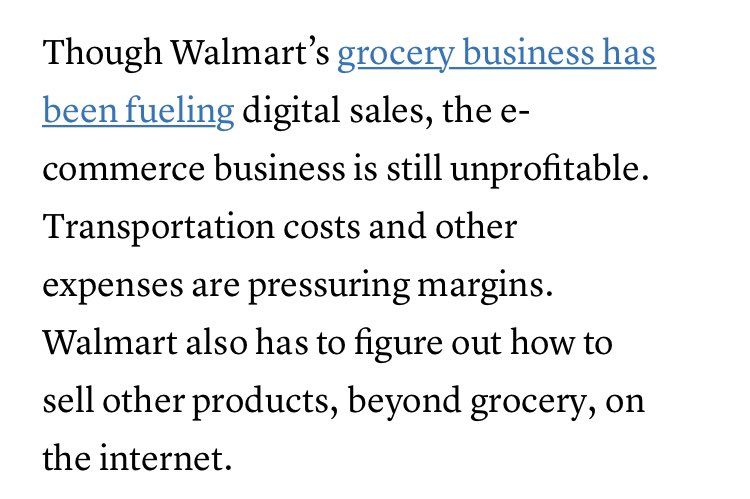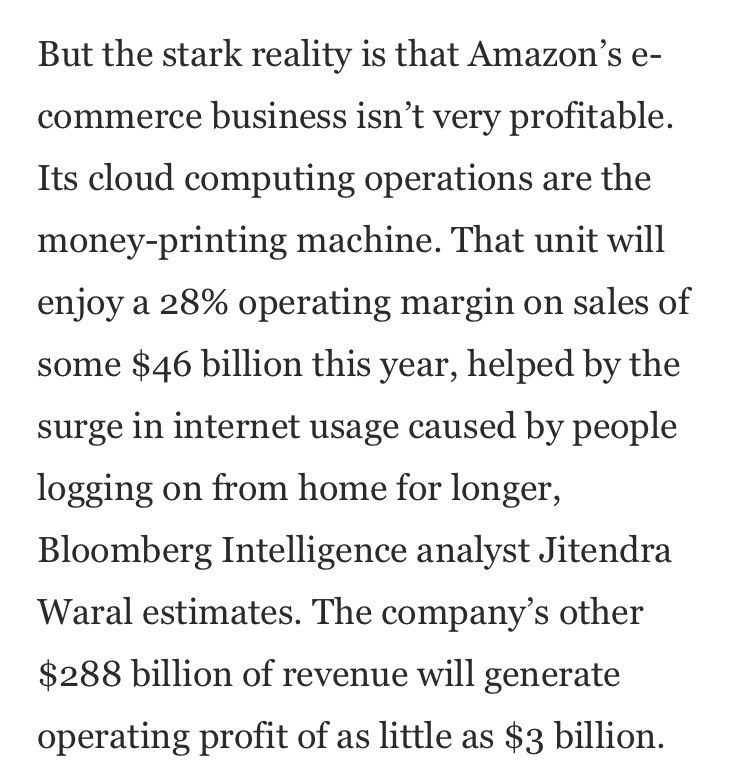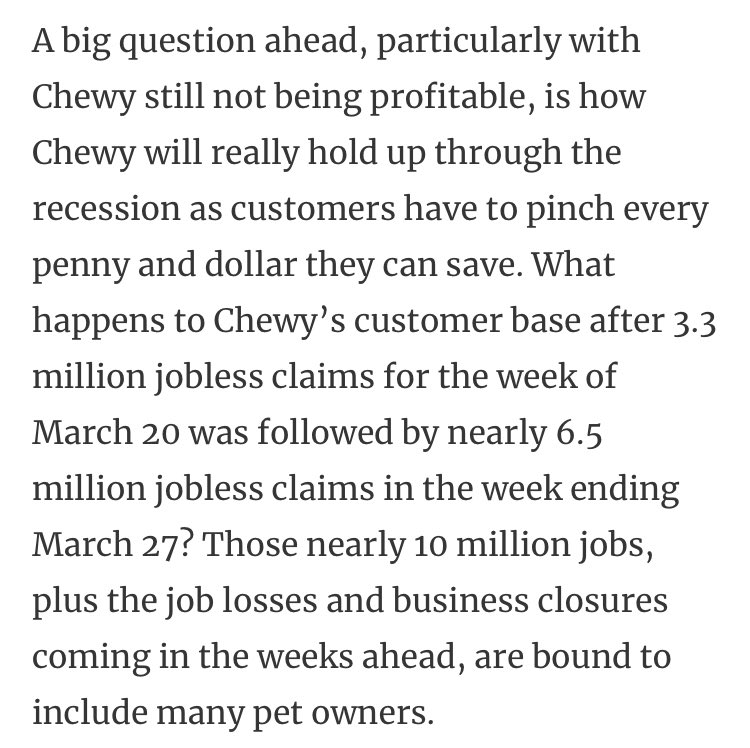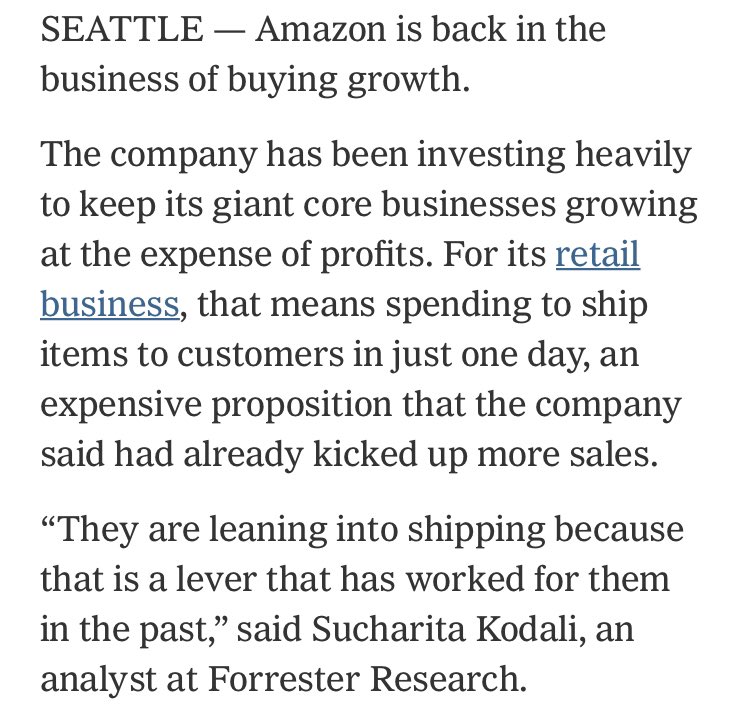Yesterday I posted about the profitability headwinds facing eCom, resulting from a shift of consumer purchasing behavior away from transacting offline (due to COVID-19 restrictions) to online retailers and brands.
Feedback was mixed, so I will unpack my point a bit more https://abs.twimg.com/emoji/v2/... draggable="false" alt="👇🏼" title="Down pointing backhand index (medium light skin tone)" aria-label="Emoji: Down pointing backhand index (medium light skin tone)">
https://abs.twimg.com/emoji/v2/... draggable="false" alt="👇🏼" title="Down pointing backhand index (medium light skin tone)" aria-label="Emoji: Down pointing backhand index (medium light skin tone)">
Feedback was mixed, so I will unpack my point a bit more
The framework of my point, which I believe was also widely misunderstood, is that when I reference future profitability, I’m focusing on the [aggregate] of eCom sales, and the [mix] of products being sold within that aggregate
Not any single brand/category, or outliers
Not any single brand/category, or outliers
Let’s examine pre-COVID eCom performance of a few major retailers.
First up: Walmart
Walmart eCom grew by 37% last year which was driven largely by grocery, but at $50B in revs their eCom segment continues to be unprofitable as noted below in a CNBC report by @laurenthomas
First up: Walmart
Walmart eCom grew by 37% last year which was driven largely by grocery, but at $50B in revs their eCom segment continues to be unprofitable as noted below in a CNBC report by @laurenthomas
Next up: Amazon
Amazon generated $160.4B in eCom merchandise sales (of $280B top-line Revs).
Amazon doesn’t report Ecom specific net income, but overall Amazon generated earnings of $14.5B in 2019
Important context:
AWS Net income: $9.2B
Prime Membership Fees: $19B
Amazon generated $160.4B in eCom merchandise sales (of $280B top-line Revs).
Amazon doesn’t report Ecom specific net income, but overall Amazon generated earnings of $14.5B in 2019
Important context:
AWS Net income: $9.2B
Prime Membership Fees: $19B
So Amazon’s profitability is driven by AWS and Prime Memberships (not to mention their growing $3.6B advertising revs)
Like Costco, they subsidize unprofitable eCom sales by passing on the costs to their customers via membership fees ($118/yr, 150M members)
[Costco: 90.3M]
Like Costco, they subsidize unprofitable eCom sales by passing on the costs to their customers via membership fees ($118/yr, 150M members)
[Costco: 90.3M]
Lastly: Chewy
The largest eCom Pet retailer IPOd in June of last year
In the most recent quarter (Q4) Chewy generated 1.35B in sales and lost $61M
In fact, the retailer has never posted a single dollar of profit in its history
The largest eCom Pet retailer IPOd in June of last year
In the most recent quarter (Q4) Chewy generated 1.35B in sales and lost $61M
In fact, the retailer has never posted a single dollar of profit in its history
So we have Amazon, Walmart and others (like Chewy) churning out massive GMV with no net income to speak of.
Why is that?
The math is simple relative to retail:
 https://abs.twimg.com/emoji/v2/... draggable="false" alt="⬇️" title="Downwards arrow" aria-label="Emoji: Downwards arrow">AOV
https://abs.twimg.com/emoji/v2/... draggable="false" alt="⬇️" title="Downwards arrow" aria-label="Emoji: Downwards arrow">AOV
 https://abs.twimg.com/emoji/v2/... draggable="false" alt="⬆️" title="Upwards arrow" aria-label="Emoji: Upwards arrow">Variable Costs
https://abs.twimg.com/emoji/v2/... draggable="false" alt="⬆️" title="Upwards arrow" aria-label="Emoji: Upwards arrow">Variable Costs
 https://abs.twimg.com/emoji/v2/... draggable="false" alt="⬇️" title="Downwards arrow" aria-label="Emoji: Downwards arrow">Gross Profit
https://abs.twimg.com/emoji/v2/... draggable="false" alt="⬇️" title="Downwards arrow" aria-label="Emoji: Downwards arrow">Gross Profit
Higher logistics and fulfillment costs in eCom drive the delta in var costs
Why is that?
The math is simple relative to retail:
Higher logistics and fulfillment costs in eCom drive the delta in var costs
COVID-19 is shifting consumer spending in three ways:
1/ Lower discretionary spending
2/ Lower aggregate spending
3/ Shift of purchasing behavior from offline to online
1/ Lower discretionary spending
2/ Lower aggregate spending
3/ Shift of purchasing behavior from offline to online
In addition to the shift in channel mix and overall lower retail sales volume, consumer behavior is creating a mix shift by category of spend:
1/ increased grocery
2/ increased consumables
3/ decreased durables
4/ decreased luxury
1/ increased grocery
2/ increased consumables
3/ decreased durables
4/ decreased luxury
This mix shift is critically important to the profitability argument:
Grocery and Consumables are typically commodities with no pricing power: lower prices, lower margins
Durables & Luxury goods carry greater perceived value-to-price relationship: higher prices, higher margins
Grocery and Consumables are typically commodities with no pricing power: lower prices, lower margins
Durables & Luxury goods carry greater perceived value-to-price relationship: higher prices, higher margins
While COVID-19 has somewhat arbitrarily created DTC winners and losers, the broader point is:
a) in terms of analysis and projecting the future, luck is a disinteresting variable
b) Lower aggregate retail sales at lower margins will ultimately hurt eCom, DTC and the economy
a) in terms of analysis and projecting the future, luck is a disinteresting variable
b) Lower aggregate retail sales at lower margins will ultimately hurt eCom, DTC and the economy
Why is it bad for DTC?
Many brands will be forced to a) lower prices and/or b) expand to marketplaces (Amazon, Walmart, etc)
This creates downward pressure on gross margins
Demand shocks for the few thriving DTC categories will swing to supply shocks, and pricing pressure
Many brands will be forced to a) lower prices and/or b) expand to marketplaces (Amazon, Walmart, etc)
This creates downward pressure on gross margins
Demand shocks for the few thriving DTC categories will swing to supply shocks, and pricing pressure
Much of this anticipated impact depends on how long the COVID crisis stretches on in the US and how deep it’s impact is felt on employment, consumer sentiment, social interaction and psychology
There will be big wins and big losses
But let’s not lose sight of the bigger picture
There will be big wins and big losses
But let’s not lose sight of the bigger picture

 Read on Twitter
Read on Twitter

![So Amazon’s profitability is driven by AWS and Prime Memberships (not to mention their growing $3.6B advertising revs)Like Costco, they subsidize unprofitable eCom sales by passing on the costs to their customers via membership fees ($118/yr, 150M members)[Costco: 90.3M] So Amazon’s profitability is driven by AWS and Prime Memberships (not to mention their growing $3.6B advertising revs)Like Costco, they subsidize unprofitable eCom sales by passing on the costs to their customers via membership fees ($118/yr, 150M members)[Costco: 90.3M]](https://pbs.twimg.com/media/EU2VtdAXQAAfWpo.jpg)

 AOVhttps://abs.twimg.com/emoji/v2/... draggable="false" alt="⬆️" title="Upwards arrow" aria-label="Emoji: Upwards arrow">Variable Costshttps://abs.twimg.com/emoji/v2/... draggable="false" alt="⬇️" title="Downwards arrow" aria-label="Emoji: Downwards arrow">Gross ProfitHigher logistics and fulfillment costs in eCom drive the delta in var costs" title="So we have Amazon, Walmart and others (like Chewy) churning out massive GMV with no net income to speak of.Why is that?The math is simple relative to retail:https://abs.twimg.com/emoji/v2/... draggable="false" alt="⬇️" title="Downwards arrow" aria-label="Emoji: Downwards arrow">AOVhttps://abs.twimg.com/emoji/v2/... draggable="false" alt="⬆️" title="Upwards arrow" aria-label="Emoji: Upwards arrow">Variable Costshttps://abs.twimg.com/emoji/v2/... draggable="false" alt="⬇️" title="Downwards arrow" aria-label="Emoji: Downwards arrow">Gross ProfitHigher logistics and fulfillment costs in eCom drive the delta in var costs" class="img-responsive" style="max-width:100%;"/>
AOVhttps://abs.twimg.com/emoji/v2/... draggable="false" alt="⬆️" title="Upwards arrow" aria-label="Emoji: Upwards arrow">Variable Costshttps://abs.twimg.com/emoji/v2/... draggable="false" alt="⬇️" title="Downwards arrow" aria-label="Emoji: Downwards arrow">Gross ProfitHigher logistics and fulfillment costs in eCom drive the delta in var costs" title="So we have Amazon, Walmart and others (like Chewy) churning out massive GMV with no net income to speak of.Why is that?The math is simple relative to retail:https://abs.twimg.com/emoji/v2/... draggable="false" alt="⬇️" title="Downwards arrow" aria-label="Emoji: Downwards arrow">AOVhttps://abs.twimg.com/emoji/v2/... draggable="false" alt="⬆️" title="Upwards arrow" aria-label="Emoji: Upwards arrow">Variable Costshttps://abs.twimg.com/emoji/v2/... draggable="false" alt="⬇️" title="Downwards arrow" aria-label="Emoji: Downwards arrow">Gross ProfitHigher logistics and fulfillment costs in eCom drive the delta in var costs" class="img-responsive" style="max-width:100%;"/>




